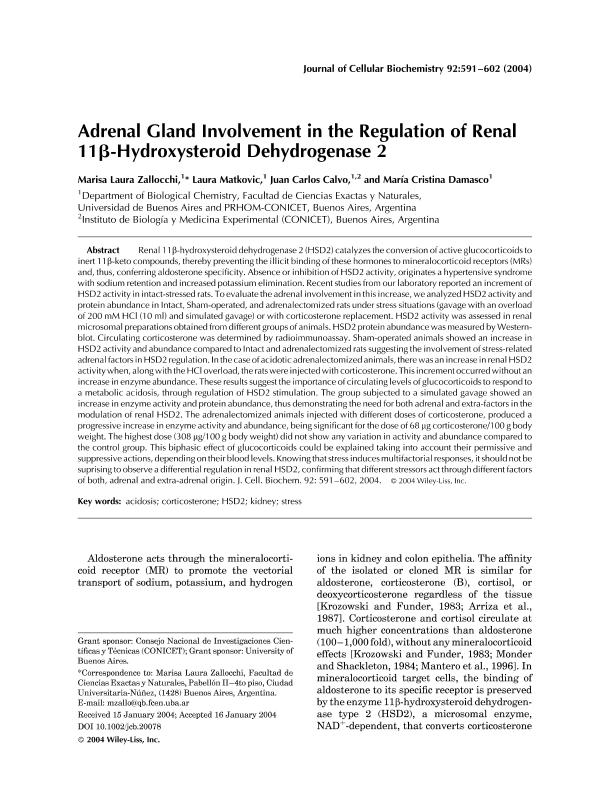Mostrar el registro sencillo del ítem
dc.contributor.author
Zallocchi, Marisa Laura
dc.contributor.author
Matkovic, Laura Beatriz

dc.contributor.author
Calvo, Juan Carlos

dc.contributor.author
Damasco, Maria Cristina

dc.date.available
2017-11-26T03:25:13Z
dc.date.issued
2004-06
dc.identifier.citation
Zallocchi, Marisa Laura; Matkovic, Laura Beatriz; Calvo, Juan Carlos; Damasco, Maria Cristina; Adrenal gland involvement in the regulation of renal 11beta-hydroxysteroid dehydrogenase 2; Wiley-liss, Inc; Journal of Cellular Biochemistry; 92; 3; 6-2004; 591-602
dc.identifier.issn
0730-2312
dc.identifier.uri
http://hdl.handle.net/11336/29120
dc.description.abstract
Renal 11beta-hydroxysteroid dehydrogenase 2 (HSD2) catalyzes the conversion of active glucocorticoids to inert 11beta-keto compounds, thereby preventing the illicit binding of these hormones to mineralocorticoid receptors (MRs) and, thus, conferring aldosterone specificity. Absence or inhibition of HSD2 activity, originates a hypertensive syndrome with sodium retention and increased potassium elimination. Recent studies from our laboratory reported an increment of HSD2 activity in intact-stressed rats. To evaluate the adrenal involvement in this increase, we analyzed HSD2 activity and protein abundance in Intact, Sham-operated, and adrenalectomized rats under stress situations (gavage with an overload of 200 mM HCl (10 ml) and simulated gavage) or with corticosterone replacement. HSD2 activity was assessed in renal microsomal preparations obtained from different groups of animals. HSD2 protein abundance was measured by Western-blot. Circulating corticosterone was determined by radioimmunoassay. Sham-operated animals showed an increase in HSD2 activity and abundance compared to Intact and adrenalectomized rats suggesting the involvement of stress-related adrenal factors in HSD2 regulation. In the case of acidotic adrenalectomized animals, there was an increase in renal HSD2 activity when, along with the HCl overload, the rats were injected with corticosterone. This increment occurred without an increase in enzyme abundance. These results suggest the importance of circulating levels of glucocorticoids to respond to a metabolic acidosis, through regulation of HSD2 stimulation. The group subjected to a simulated gavage showed an increase in enzyme activity and protein abundance, thus demonstrating the need for both adrenal and extra-factors in the modulation of renal HSD2. The adrenalectomized animals injected with different doses of corticosterone, produced a progressive increase in enzyme activity and abundance, being significant for the dose of 68 microg corticosterone/100 g body weight. The highest dose (308 microg/100 g body weight) did not show any variation in activity and abundance compared to the control group. This biphasic effect of glucocorticoids could be explained taking into account their permissive and suppressive actions, depending on their blood levels. Knowing that stress induces multifactorial responses, it should not be surprising to observe a differential regulation in renal HSD2, confirming that different stressors act through different factors of both, adrenal and extra-adrenal origin.
dc.format
application/pdf
dc.language.iso
eng
dc.publisher
Wiley-liss, Inc

dc.rights
info:eu-repo/semantics/openAccess
dc.rights.uri
https://creativecommons.org/licenses/by-nc-nd/2.5/ar/
dc.subject
Endocrinology
dc.subject
Adrenal Glands
dc.subject
Corticosterone
dc.subject
Gene Expression Regulation
dc.subject
Adrenalectomy
dc.subject.classification
Bioquímica y Biología Molecular

dc.subject.classification
Ciencias Biológicas

dc.subject.classification
CIENCIAS NATURALES Y EXACTAS

dc.subject.classification
Inmunología

dc.subject.classification
Medicina Básica

dc.subject.classification
CIENCIAS MÉDICAS Y DE LA SALUD

dc.title
Adrenal gland involvement in the regulation of renal 11beta-hydroxysteroid dehydrogenase 2
dc.type
info:eu-repo/semantics/article
dc.type
info:ar-repo/semantics/artículo
dc.type
info:eu-repo/semantics/publishedVersion
dc.date.updated
2017-11-16T15:13:27Z
dc.identifier.eissn
1097-4644
dc.journal.volume
92
dc.journal.number
3
dc.journal.pagination
591-602
dc.journal.pais
Estados Unidos

dc.journal.ciudad
Nueva York
dc.description.fil
Fil: Zallocchi, Marisa Laura. Universidad de Buenos Aires. Facultad de Ciencias Exactas y Naturales. Departamento de Química Biológica; Argentina. Consejo Nacional de Investigaciones Científicas y Técnicas. Prog.de Regulación Hormonal y Metabolica(p); Argentina
dc.description.fil
Fil: Matkovic, Laura Beatriz. Universidad Catolica de Córdoba. Facultad de Medicina. Departamento de Química Biologica; Argentina. Consejo Nacional de Investigaciones Científicas y Técnicas. Prog.de Regulación Hormonal y Metabolica(p); Argentina
dc.description.fil
Fil: Calvo, Juan Carlos. Universidad de Buenos Aires. Facultad de Ciencias Exactas y Naturales. Departamento de Química Biológica; Argentina. Consejo Nacional de Investigaciones Científicas y Técnicas. Instituto de Biología y Medicina Experimental. Fundación de Instituto de Biología y Medicina Experimental. Instituto de Biología y Medicina Experimental; Argentina
dc.description.fil
Fil: Damasco, Maria Cristina. Universidad de Buenos Aires. Facultad de Ciencias Exactas y Naturales. Departamento de Química Biológica; Argentina. Consejo Nacional de Investigaciones Científicas y Técnicas. Prog.de Regulación Hormonal y Metabolica(p); Argentina
dc.journal.title
Journal of Cellular Biochemistry

dc.relation.alternativeid
info:eu-repo/semantics/altIdentifier/url/http://onlinelibrary.wiley.com/doi/10.1002/jcb.20078/full
dc.relation.alternativeid
info:eu-repo/semantics/altIdentifier/doi/http://dx.doi.org/10.1002/jcb.20078
dc.relation.alternativeid
info:eu-repo/semantics/altIdentifier/pmid/15156570
Archivos asociados
